Powet Alphabet: B is for Blackest Night
by Sean "TheOrange" Corse, filed in Comics, Powet Alphabet on Jan.09, 2010
Since the alphabet is the building block of our language, the Powet Alphabet is the building block of what makes us geeks.
One of the many ways one becomes a geek is by absorbing the minutiae and esoterica of any particular medium. Comic books are perfect for this, with multiple titles and weekly stories that span months and even years. But what happens when you become a lifetime comic book geek? Then you have to keep track of stories that span generations.
Blackest Night, DC’s most recent (and most recently successful) crossover event, is the ultimate fan wank for longtime readers of the DCU. Death may be a revolving door in comic books, but for some 2nd and 3rd string characters it is rather more permanent. Blackest Night brings back nearly every “permanently” deceased character for the last 20+ years since 1986, and provides and explanation for why the first-stringers can’t seem to stay dead.
Find out how this great strength of story for long-time fans is also this event’s greatest weakness, and what we can come to expect from a universe where the near-absolute authority of the Green Lanterns seems to be drawing to a close.
Prophecies
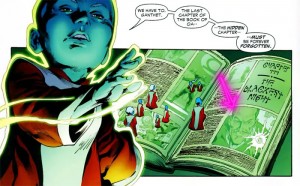 The title comes from the first line of the Green Lantern oath, “In brightest day, in blackest night…”, that all Lanterns must say before powering up their uber-powerful rings. (Don’t know what a Green Lantern is? Oh boy, you’re in trouble! Our Y article about “Yellow Lanterns” should fill you in just nicely.) Prophecies, both new and in reference to material decades old, have become the modus operandi of the Green Lantern titles ever since Geoff Johns brought Hal Jordan back from the dead (WHAT DID I TELL YOU!?). In a 1986 Green Lantern annual, one such prophecy told to Abin Sur about the end of the Green Lantern Corps nearly came to fruition in 2007’s Sinestro Corps War event, where Ranx the Sentient City returned to detonate a bomb at the heart of Mogo — a sentient planet and Green Lantern.
The title comes from the first line of the Green Lantern oath, “In brightest day, in blackest night…”, that all Lanterns must say before powering up their uber-powerful rings. (Don’t know what a Green Lantern is? Oh boy, you’re in trouble! Our Y article about “Yellow Lanterns” should fill you in just nicely.) Prophecies, both new and in reference to material decades old, have become the modus operandi of the Green Lantern titles ever since Geoff Johns brought Hal Jordan back from the dead (WHAT DID I TELL YOU!?). In a 1986 Green Lantern annual, one such prophecy told to Abin Sur about the end of the Green Lantern Corps nearly came to fruition in 2007’s Sinestro Corps War event, where Ranx the Sentient City returned to detonate a bomb at the heart of Mogo — a sentient planet and Green Lantern.
Blackest Night is a much newer prophecy, but retconned as an ancient Revelations-like chapter in the Book of OA, raising an otherwise innocuous statement to great prominence that would become the ultimate expression of the “emotional spectrum”, first mentioned in 2004’s Green Lantern: Rebirth story. The Blackest Night tells of the inhabitants of our the first “dark matter” inhabitants of this universe before their was light rising up against all life; only the Green Lanterns and its six sister Corps would be able to stand in their way.
Rise of the Black Lanterns
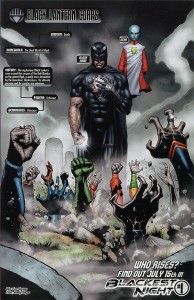 Unlike the other Corps, however, the Black Lanterns are populated by the dead. Not just any dead: specifically those to whom the living still have strong emotional ties. The Black Lantern power rings reanimate (and make nearly invincible) the bodies of deceased heroes and civilians alike to provoke a stark emotional response from their targets; at the peak of this response the Black Lanterns rip their victim’s heart out and “eat” the emotion. The worst part? The newly deceased become great candidates to be new Black Lanterns! As the living lose, their opponents become ever stronger.
Unlike the other Corps, however, the Black Lanterns are populated by the dead. Not just any dead: specifically those to whom the living still have strong emotional ties. The Black Lantern power rings reanimate (and make nearly invincible) the bodies of deceased heroes and civilians alike to provoke a stark emotional response from their targets; at the peak of this response the Black Lanterns rip their victim’s heart out and “eat” the emotion. The worst part? The newly deceased become great candidates to be new Black Lanterns! As the living lose, their opponents become ever stronger.
This makes the story unique on several levels.
First, it tells (at least in short form) the stories of the dead who have come back to haunt the living, and the circumstances around their deaths as the Black Lantern rings “download” the memories of the person they are about to welcome into the Corps. How the character feels about this death plays into the vignette told through the heroes the newly-minted Lantern has come back to torment. This setup brings a sense of accountability and consequence for older readers, as well as provides a quick history lesson for newer readers.
Second, it provides concise character pieces for the heroes who usually, but not always, survive the encounter. For some, it provides a depth where little existed before. For others, a new dimension to their personalities is uncovered. All of them must fight against their emotions and face feelings of blame, loss, self-doubt, and guilt surrounding the deaths of their loved ones.
Last, and certainly not least, it provides an in-universe explanation for why so many of the top-tier heroes seem to cheat death time and again. We all know the real reason, of course, but making a story based on the realities of comic book publishing is nothing short of a stroke of genius. Superman? Barry Allen? Wonder woman? Hal Jordan and Oliver Queen? At the time, they died (or close enough to it) to make way for a new generation and increase sales. But now? It’s for a “reason”.
Nekron
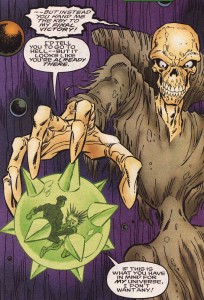 That reason is a third-string bad guy, gatekeeper to the realm of the dead. Nekron has faced both Hal Jordan and Kyle Rayner in the long history of the Green Lantern books, but was always beaten back. Now we find out that since the events of the Crisis of Infinite Earths, starting with the apparent death of Flash Barry Allen, Nekron has been running a long game to claim the realm of the living as his own, and destroy “Light” forever.
That reason is a third-string bad guy, gatekeeper to the realm of the dead. Nekron has faced both Hal Jordan and Kyle Rayner in the long history of the Green Lantern books, but was always beaten back. Now we find out that since the events of the Crisis of Infinite Earths, starting with the apparent death of Flash Barry Allen, Nekron has been running a long game to claim the realm of the living as his own, and destroy “Light” forever.
William Hand, another old Green Lantern villain, emerged as Nekron’s right-hand (haha) man, bringing out the conditions needed to allow Nekron entry into the realm of the living once again — this time to rule it forever.
As the final issues of Blackest Night approach, Nekron and the Black Lantern power battery have risen from the paved-over ashes of Coast City (destroyed by Hank Henshaw/the Cyborg Superman and Mongul during 1993’s Reign of Supermen storyline); Xanshi, a planet that Green Lantern John Stewart feels responsible for allowing to be destroyed, has been reanimated like Mogo and is on its way to Earth. With millions and billions of dead, reanimated Black Lanterns gathering for a final assault on all life, how will our heroes prevail when the mightiest (and most-resurrected among them) can not be counted among this Corps’ members?
(This article at Again With the Comics does a much better job explaining Nekron’s many appearances, and why he was an “obvious” shoe-in to be the major villain of this storyline.)
The White Light of Creation
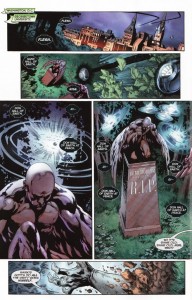 Many of the mysteries of the Black Lanterns were released slowly in the build-up to and during the course of this event. The accumulated knowledge above was collected over the course of months. One remaining mystery is the White Light of Creation, first mentioned by the mysterious Indigo Tribe. This tribe themselves was formed in response to a prophecy, and claim Abin Sur as their savior and prophet — also one of the remainin mysteries in this story. So far the only beings that seems capable of naturally harnessing this power has been the current Dove of Hawk and Dove fame. The current Dove’s predecessor was also the only one that the Black Lanterns were unable to resurrect because he was “at peace”. The current Dove is able to sever the connection of the Black rings to those they possess — a power that has only been demonstrated elsewhere by a Green Lantern pairing with another of the emotional spectrum.
Many of the mysteries of the Black Lanterns were released slowly in the build-up to and during the course of this event. The accumulated knowledge above was collected over the course of months. One remaining mystery is the White Light of Creation, first mentioned by the mysterious Indigo Tribe. This tribe themselves was formed in response to a prophecy, and claim Abin Sur as their savior and prophet — also one of the remainin mysteries in this story. So far the only beings that seems capable of naturally harnessing this power has been the current Dove of Hawk and Dove fame. The current Dove’s predecessor was also the only one that the Black Lanterns were unable to resurrect because he was “at peace”. The current Dove is able to sever the connection of the Black rings to those they possess — a power that has only been demonstrated elsewhere by a Green Lantern pairing with another of the emotional spectrum.
So how will our heroes prevail? Anyone with a basic knowledge of electromagnetism knows that the visible spectrum of light seen altogether appears white. The answer, then, is clearly going to be a Mighty-Morphin’-Power-Rangers-style White Lantern. Given his exposure to nearly every other type of ring, and personal connections to the other Corps (Sinestro with his Yellow lanterns in the Sinestro Corps, Carol Ferris as the premiere Star Sapphire, Ganthet as leader of the Blue Lantern Corps), clearly the man for the job is Hal Jordan.
Or maybe Sodam Yat. Or Dove. I haven’t decided yet.
Too much for new readers?
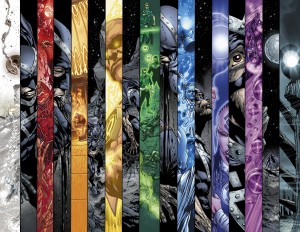 Because it’s so steeped in history, there’s a good chance that most of what happens will mean nothing to the average reader trying to get a toe-hold into this event. Learning about the history of existing characters might be enough to overcome this gap in knowledge, but are the stories compelling enough?
Because it’s so steeped in history, there’s a good chance that most of what happens will mean nothing to the average reader trying to get a toe-hold into this event. Learning about the history of existing characters might be enough to overcome this gap in knowledge, but are the stories compelling enough?
I had to ask myself that question when reading the R.E.B.E.L.S. tie-in book. I knew nothing of Brainiac 2 or the history of the book. The Black Lantern who appeared was the mother of Brainiac 2’s son (whom he murdered himself). I can’t tell if it was the uninteresting characters or the uninteresting premise, but it was the first glimpse I got into what it must be for the man-on-the street to walk into a comic store and try to make heads or tails of these stories.
Hopefully the previous 3-part minis — Batman, Teen Titans, Superman, Flash, and Wonder Woman — will provide enough of a background to get a toe-hold. If you feel lost, try to track down these books first before reading the main book or any of the other tie-ins. Until recently, this event was also fairly crossover-light, with nearly every installment shedding some new important insight as to the nature of the Black Lanterns and how they will eventually be stopped. I also hope that this article will provide a framework to begin to understand why this is one of the greatest comic book events of all time, inadvertently 25 years in the making!


 PS3
PS3
 Famicom Dojo
Famicom Dojo KEEP PLAYING
KEEP PLAYING KEEP PLAYING: Rewind
KEEP PLAYING: Rewind Powet Toys
Powet Toys Powetcast
Powetcast Hitchhiker's Guide POWETcast
Hitchhiker's Guide POWETcast
















Pingback: Powetcast Episode 26: We’re With Coco - POWET.TV